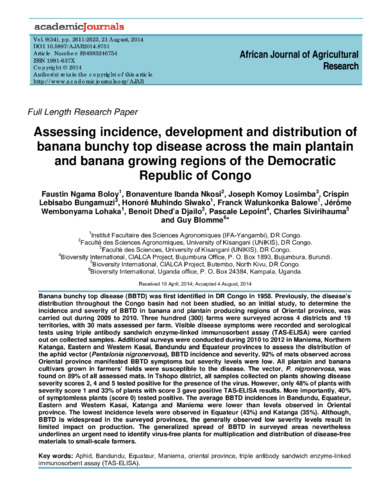Assessing incidence, development and distribution of banana bunchy top disease across the main plantain and banana growing regions of the Democratic Republic of Congo
Banana bunchy top disease (BBTD) was first identified in DR Congo in 1958. Previously, the disease’s distribution throughout the Congo basin had not been studied, so an initial study, to determine the incidence and severity of BBTD in banana and plantain producing regions of Oriental province, was carried out during 2009 to 2010. Three hundred (300) farms were surveyed across 4 districts and 19 territories, with 30 mats assessed per farm. Visible disease symptoms were recorded and serological tests using triple antibody sandwich enzyme-linked immunosorbent assay (TAS-ELISA) were carried out on collected samples. Additional surveys were conducted during 2010 to 2012 in Maniema, Northern Katanga, Eastern and Western Kasai, Bandundu and Equateur provinces to assess the distribution of the aphid vector (Pentalonia nigronervosa), BBTD incidence and severity. 92% of mats observed across Oriental province manifested BBTD symptoms but severity levels were low. All plantain and banana cultivars grown in farmers’ fields were susceptible to the disease. The vector, P. nigronervosa, was found on 89% of all assessed mats. In Tshopo district, all samples collected on plants showing disease severity scores 2, 4 and 5 tested positive for the presence of the virus. However, only 48% of plants with severity score 1 and 33% of plants with score 3 gave positive TAS-ELISA results. More importantly, 40% of symptomless plants (score 0) tested positive. The average BBTD incidences in Bandundu, Equateur, Eastern and Western Kasai, Katanga and Maniema were lower than levels observed in Oriental province. The lowest incidence levels were observed in Equateur (43%) and Katanga (35%). Although, BBTD is widespread in the surveyed provinces, the generally observed low severity levels result in limited impact on production. The generalized spread of BBTD in surveyed areas nevertheless underlines an urgent need to identify virus-free plants for multiplication and distribution of disease-free materials to small-scale farmers.

